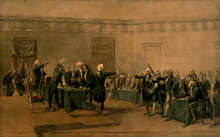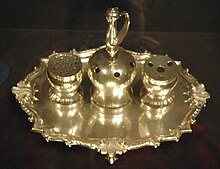Signing of the United States Declaration of Independence
The Second Continental Congress adopted the Declaration of Independence on July 4, 1776, with 12 of the 13 colonies voting in favor and New York abstaining.
Thomas Jefferson, Benjamin Franklin, and John Adams all wrote that it was signed by Congress on the day when it was adopted on July 4, 1776.
The proceedings for 1776 were first published in 1777, and the entry for July 4 states that the Declaration was engrossed and signed on that date (the official copy was handwritten by Timothy Matlack).
[11] Ritz argues that the engrossed copy of the Declaration was signed by Congress on July 4, as Jefferson, Adams, and Franklin had stated, and that it was implausible that all three men had been mistaken.
According to Ritz, this resolution did not call for a new document to be created, but rather for the existing one to be given a new title, which was necessary after New York had joined the other 12 states in declaring independence.
[14] In an 1811 letter to Adams, Benjamin Rush recounted the signing in stark fashion, describing it as a scene of "pensive and awful silence".
Rush said the delegates were called up, one after another, and then filed forward somberly to subscribe what each thought was their ensuing death warrant.
"[15] According to Rush, Harrison’s remark "procured a transient smile, but it was soon succeeded by the Solemnity with which the whole business was conducted.”[15] Fifty-six delegates eventually signed the Declaration of Independence: President of Congress New Hampshire Massachusetts Bay Rhode Island and Providence Plantations Connecticut New York New Jersey Pennsylvania Delaware Maryland Virginia North Carolina South Carolina Georgia
Some delegates were away on business when the Declaration was debated, including William Hooper[22] and Samuel Chase, but they were back in Congress to sign on August 2.
Other delegates were present when the Declaration was debated but added their names after August 2, including Lewis Morris, Oliver Wolcott, Thomas McKean, and possibly Elbridge Gerry.
Richard Henry Lee and George Wythe were in Virginia during July and August, but returned to Congress and signed the Declaration probably in September and October, respectively.
[25] By the time that he signed it, there wasn't any space for his name next to the other New Hampshire delegates, so he placed his signature at the end of the document.





